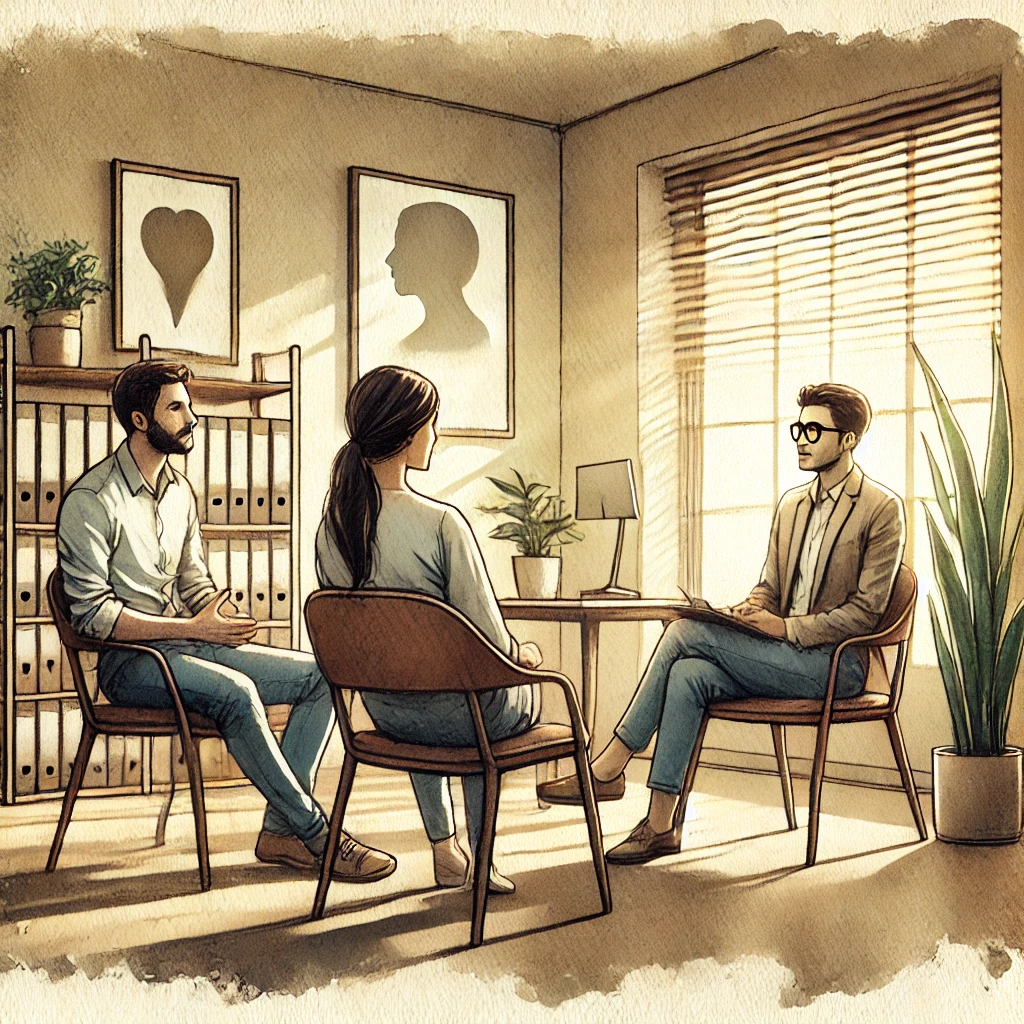
Is Marriage Therapy Covered by Insurance? A Psychoanalytic Exploration of Barriers and Possibilities

Humans are, by our very nature, wired for connection, a fact most obvious in our closest relationships. English psychoanalyst and pediatrician Donald W. Winnicott (1975) once (in)famously quipped “there is no such thing as a baby…If you show me a baby you certainly show me also someone caring for the baby.” This is, of course, to say that from the moment we take our first breath we are in a relationship with another person, immediately shaping our capacity both for intimacy and trust or for grave rupture. Decades of research have demonstrated that the patterns set in motion by our earliest relationships with parents, siblings, and important others will necessarily play out in all of our other relationships throughout the lifespan – one way or another. More recently, psychoanalyst Jonathan Shedler (2021) continued this line of thought in a clinical vein, saying “show me someone who comes to therapy with a psychological problem of any kind and I’ll show you someone who’s having some kind of difficulty in relationships. Either the problem is playing out in the relationship or it’s getting in the way of having any relationships. You can’t disconnect the problem from the relational context in which it occurs.” Both clinicians refer here to our social relationships broadly, but the intimacy of a romantic and/or sexual partnership brings these patterns into sharp focus. In such relationships, our partner often has a front-row seat to all the vicissitudes of our humanity – and we to theirs. Thus, in any such relationship of closeness and meaning, conflict will arise to varying degrees. Usually, the partners involved in these conflicts are entangled in it emotionally and practically to the degree that it can be frustratingly difficult to imagine how to stop the cycle, let alone understand their own contributions to it. This is where the measured pacing, intentionality, and relative objectivity of couple therapy can be serviceable.
Though we are at a moment when the prioritization of mental health and psychological needs have perhaps never been less stigmatized, therapy specifically focusing on partnerships – often interchangeably called marriage counseling, relationship counseling, or simply couple therapy – still frequently seems daunting terrain to many. In media, television programs such as Orna Guralnik’s Couples Therapy on Showtime and Esther Perel’s Where Should We Begin? podcast (and tie-in game) have quite prominently taken steps to demystify the growing number of couples and partnerships seeking help dealing with relationship challenges. But what should potential clients expect from couple therapy? With practitioners as diverse as the relationship configurations they treat, how can therapy effectively approach the manifold needs of the couple in crisis?
First, those in search of counseling for healthy relationships should be aware that they are hardly alone in this endeavor. Lebow and Snyder (2022) note a rise in couples seeking therapy and identify three key contributing factors: the high prevalence of couple distress – citing Kreider & Ellis’s (2011) finding of a 40-50% divorce rate in the U.S., increased recognition of the adverse role of relationship distress on the emotional wellbeing of both adult partners and their children, and the evolution of higher (and changing) expectations of contemporary relational life.
Practically speaking, these broader cultural data point to behaviors that are familiar to both couples and couple therapists alike in the form of being stuck endlessly in what feels like the same argument or conflict, trust issues, diverging attitudes about having children and parenting, drug and alcohol problems, conflict resolution, financial stress, and infidelity. Of course, there are just as many parallels with couples and romantic partnerships who seek psychotherapy for apparently adaptive reasons such as deepening an already successful relationship, seeking more fun, better sex, emotional growth, preparing for an anticipated change in the relationship, or, simply, getting serious about getting serious.
As with individual psychotherapy, for the partnership seeking treatment, it’s likely that their usual methods of conflict resolution – avoidance, taking a “break,” seeking distractions, consulting Dr. Google, or the well-intentioned advice of friends and family – have proven unsuccessful or lacking in adequately addressing communication breakdowns, emotional disconnection, and the like. This is where the professional, grounded in a specific modality of treating couples, comes in.
While not an exhaustive (and, admittedly, a radically-simplified) list of types of couple therapy, those seeking treatment are likely to encounter three big names: The Gottmann Method, a highly-structured, manualized, skill-based approach; Emotionally-Focused Therapy (EFT), which draws from Attachment Theory to help couples express and meet deeply-seated emotional needs; and Internal Family Systems (IFS), a technique used with individuals and couples alike to identify how one’s development and positioning in early relationships, typically one’s family of origin, shapes and often interferes with their adaptive functioning in present relationships.
Each of these techniques, however, can trace their origins back to psychoanalysis, the oldest and one of the most enduring modes of psychotherapy. Its essential premise seeks to understand how thoughts and feelings outside of our awareness (what is known as the “unconscious”) impacts our behaviors and relationships and (much like the emphases of EFT and IFS) often stem from our experiences with our early caregivers and significant developmental events. Contemporary psychodynamic psychotherapy retains many of the theoretical positions of psychoanalysis while offering a somewhat “modernized” structure akin to the majority of present models of so-called “talk therapy.” As a practice, Bay Psychology Group (BPG) offers and trains its clinicians in providing this method of treatment, addressing underlying issues that impede flourishing relationships and helping clients truly reconnect with their partner rather than relying on symptomatic quick-fixes that often lead to recidivism and relapse.
Psychodynamically-oriented couple therapy acknowledges, as noted above, that a good deal of why our relationships – in the romantic/intimate sense and otherwise – look the way they do owes to our selection of the kinds of partners that will reflect qualities of those early relationships: “The unconscious choice of partner will therefore be determined by the partner’s receptivity to the split off, disowned, and projected parts of the self [In other language, parts of ourselves outside of our awareness that we use various unconscious tactics to defend ourselves from knowing or seeing]. This will be a shared system with each partner acting to some degree as a container for the other’s unconscious hopes of repeating what was good, repairing what was bad or missing, and carrying that which felt unbearable in earlier primary relationships…By making such a choice, by creating what may be described as a marital fit, the couple could be said to be embarking on an unconscious contract for the purposes of development and defence” (Ruszczynski, 1992, p.36).
Change in couples therapy begins, then, by exploring each partner’s expectations, perceptions, and emotional needs of the partner and the relationship itself. By examining each partner’s individual developmental and childhood history, an opportunity is created for couples to bear witness to and better understand the meaning of their partner’s present thoughts, feelings, and behavior, laying the groundwork for deepening empathy. This also allows for individual awareness of feelings and experiences that are potentially being “acted out” rather than being understood and communicated. The new patterns of relating based on a developmental and in-depth understanding of each other helps forge and strengthen a relationship based in reality – of who each partner truly is and what each authentically wants and chooses, based on open, emotionally-honest communication instead of assumptions and “mind-reading,” disrupting the sense of experiencing the same conflict, argument, or pattern again and again that bring so many couples to treatment.
Such new patterns are seated in levels of thinking and feeling of which words and skills can often only begin to scratch the surface. Indeed, there are numerous self-help workbooks and skill guides specifically geared toward martial and relational conflict. Such interventions (e.g. the very popular Nonviolent Communication), as stated above, are frequently and understandably the first line of defense for couples in distress. Though often efficacious in temporarily defusing immediate heated conflict, merely changing our words or asking in a different way for our needs to be met often does more to obfuscate deeper-seated patterns of relating than to approach the root of why they exist in the first place. Balint (1993) writes “Words form only a small part of communication in general…Often the person who wants to communicate does not himself consciously know what he wants to say…a husband may communicate with his wife without being aware he has. Or the wife may be aware that something has been meant (by, for instance, a gesture or frown) but may not be quite clear what it was and may not know consciously that she has responded to this” (p. 34). To be sure, anyone who has been in a partnership of any significant intimacy and duration is likely well aware of their own and the other’s capacity to become attuned in extremis to even the most subtle of behaviors, far beyond a mere misalignment of “communication skills.”
To this point, it is often said that couple therapists treat the relationship as opposed to the individual members of the partnership. This is to say the therapist is positioned as an “observer,” or even something of a nominal “third member” of the couple in treatment. Information gathered, observed, and shown back to the couple by this insider/outsider stance helps them develop their own capacity to reflect on their behaviors and interactions in the relationship. Psychoanalyst Mary Morgan (2019) refers to this ability of partners to think about themselves as a couple and the nature of what their couple-ness stands for, a function often missing from relationships, as a “couple state of mind.” She writes, “…if the therapy progresses well, this becomes internalised by the couple as a part of their own relationship. The capacity of the couple to hold a couple state of mind can be seen in the unfolding of the therapy as the couple starts to think together about what is happening between them” (p.xxiii).
All relationships struggle, and each struggles in ways as unique as the partnerships who comprise them. Couple therapy (nor individual therapy, for that matter) could never begin to eliminate all conflict – and after all, friction also leads to growth. Learning to navigate, reflect on, safely discuss, and grow from that conflict are key to developing relationships, marriages, and partnerships that thrive in accordance with each partner’s definition of success. Put simply, Morgan (2019) continues, “They still have arguments, but they…[are] able to talk about it the next day and reflect on what might have gone wrong” (p.xxiii).
At BPG, we are committed to helping a diversity of couples and partnerships develop and strengthen this “couple state of mind,” reconnect with their partners, and improve trust, resilience, stability, and relationship health.
Change takes effort and can be hard work. While sharing the more challenging aspects of your inner world with your partner can feel intimidating, meaningful, insight-oriented couple therapy can lead to meaningful and lasting growth. Reach out today to start couples therapy, either in-person at our Rockridge office in Oakland or via telehealth.
Balint, E. Unconscious communication between husband and wife. Psychotherapy with couples: theory and practice at the Tavistock Institute of marital studies (S.P. Ruszczynski, Ed.). Routledge.
Greenbaum, E. [picturingitwithelliot3293]. (2021, September 6. The 7 Principles of Psychoanalytic Psychotherapy [Video]. YouTube. https://youtu.be/YNWy1ksxIDo?si=nd_OjykTU4BsM8tB.
Lebow, J., & Snyder, D. (2022). Couple therapy in the 2020s: Current status and emerging developments. Family process, 61(4), 1359–1385. https://doi.org/10.1111/famp.12824.
Morgan, M. (2019). A couple state of mind: Psychoanalysis of couples and the Tavistock relationships model. Routledge.
Ruszczynski, S.P. (1992). Notes towards a psychoanalytic understanding of the couple relationship. Psychoanalytic Psychotherapy, 6(1), 33-88. https://pep-web.org.
Winnicott, D. W. (1975). Anxiety associated with insecurity. Through paediatrics to psycho-analysis: collected papers (pp. 99). The International Psycho-Analytical Library.